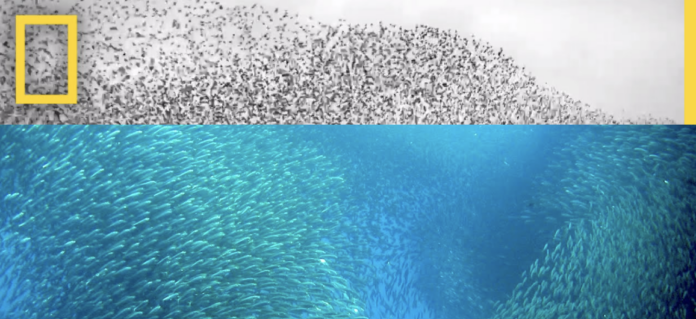Models of self-organization have proved useful in revealing what processes may underlie characteristics of swarms. In this study, we review model-based explanations for aspects of the shape and internal structure of groups of fish and of birds traveling undisturbed (without predator threat). Our models attribute specific collective traits to locomotory properties. Fish slow down to avoid collisions and swim at a constant depth, whereas birds fly at low variability of speed and lose altitude during turning. In both the models of fish and birds, the ‘bearing angle’ to the nearest neighbour emerges as a side-effect of the ‘blind angle’ behind individuals and when group size becomes larger, temporary subgroups may increase the complexity of group shape and internal structure. We discuss evidence for model-based predictions and provide a list of new predictions to be tested empirically. Model-based explanations have highlighted the importance of properties of locomotory behaviour and sensory perception. For instance, owing to swimming at a constant depth and slowing down to avoid collisions, the shape of schools is oblong. The larger vertical movements of flocks of birds due to their rolling during turning cause a shape that is variable in the vertical direction. Speed is more constant in our models of birds than of fish due to the constraints imposed by flying. This leads to more variation in the orientation of shape relative to its movement direction during turning in flocks of birds than in schools of fish. In the case where flocks move straight forward, the orientation of their shape depends on the initial orientation. Low variability of speed also leads to a more homogeneous distribution of density in the group than variable speed does, which explains the difference in density distribution between fish schools and bird flocks. Interactions that are more local (in the case of a lower number of interaction partners, a larger group, or both) result in a more complex shape and structure of groups of both fish and birds.
Reflexive Analysis
Again I found the imagery associate with this topic to be very interesting. Schools of fish and flocks of birds are visually interesting and similar. The connection between flight and swimming has been fresh in my mind after body surfing recently. Body surfing is essentially interacting with a vortex to move through a fluid. Seeing fish swim together and gulls fly together was thought provoking as well. This article sort of serves to tie all of those thoughts together for me. There is an aesthetic interest as well as the potential to use water as some form of metaphor in a design solution for our partners in Dayton. Traveling through or visually manipulating air may not be so simple to demonstrate, and perhaps too on the head. This could be a subversive angle conceptually, while practically it could prove intuitive to use water rather than air as a fluid demonstration. Scientifically this article explains how wake, which is mentioned in other articles, contributes to the animals’ sense of space in a group.
Sources
Hemelrijk, C. K., & Hildenbrandt, H. (2012, December 6). Schools of fish and flocks of birds: Their shape and internal structure by self-organization. Interface focus. https://www.ncbi.nlm.nih.gov/pmc/articles/PMC3499122/




